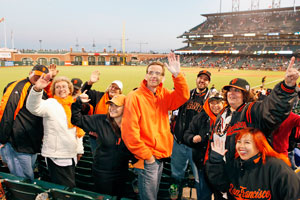Guest Post by Robert Sagers
Those seated out by left field at AT&T Park, the home of the San Francisco Giants, could teach us a lot about the church and the people who compose it. Seriously.

There’s a diverse crew of fans seated out there, fans who’ve been taking games in, together, for years. None of them knew one another before they started watching these baseball games, writer Tim Keown notes, but “now they celebrate births, mourn deaths and mark the passage of time by baseball milestones.”
Nowhere else, the writer seems to imply, could such community, such “camaraderie,” be found.
Where else can you find camaraderie like this? Where else can people gather and share this much life? In your neighborhood? Chances are, the folks next door and across the street are too consumed with their jobs and their kids and their bills to sit around together for three hours 81 times a year. At the office? It’s unlikely that corporate hierarchies and petty infighting could ever be dropped long enough to foster the kind of egalitarian bonhomie found in and around (section) 135.
Separate, these fans are individuals, but when they come together for a game, they are a unit, a unity. “Together they’re a collection of Everybodies—professors and lawyers, retirees and Little Leaguers—who come together during every homestand to become a collective Somebody,” Keown writes. “It started with baseball and spilled over into life beyond the ballpark.”
It can be easy, in our sin, to allow such “a common interest” as baseball—or a favorite television show, or a favorite outdoor activity, or a favorite theologian—to take the place of the One who made us. “You stir man to take pleasure in praising you, because you have made us for yourself,” Augustine said, to God, “and our heart is restless until it rests in you.”
But the reality of the church—true community, true fellowship—means that we can stop searching around in the darkness for some common interest to unite us, for a sort of pseudo-church (to borrow Russell Moore’s phrase). In Christ, a common interest—the common interest—has already found us.
The gospel, as Moore says, is the lowest common denominator for those who know Christ—and the fact that you may have two people spending time with one another who have nothing else in common but their faith in Jesus is a sign of Christ’s lordship.
To borrow, and alter, Keown’s words above: Together, the church is a collection of Everybodies—professors and lawyers, retirees and Little Leaguers, stay-at-home moms and web designers, high school students and nursing home volunteers—who come together in Christ to become a collective Somebody. It started with the gospel—with the kingdom, and a common King—and spilled over into life beyond Sunday mornings.
In the body of Christ, we’re no longer fans; in the church, we’re family. And that’s something far more lasting, much more life giving, far more community building than anything at any ballpark anywhere.
I hope those “in and around 135” find true community, if they haven’t already. The article makes it seem as though they are longing for something—even if they don’t yet know what it is.
And I hope those within our own churches might learn something from these baseball fans—something about the longing to belong, to commune, to be known. They’re no different than we were.
After all, apart from Christ, we’d all still be searching for something out of left field.


















